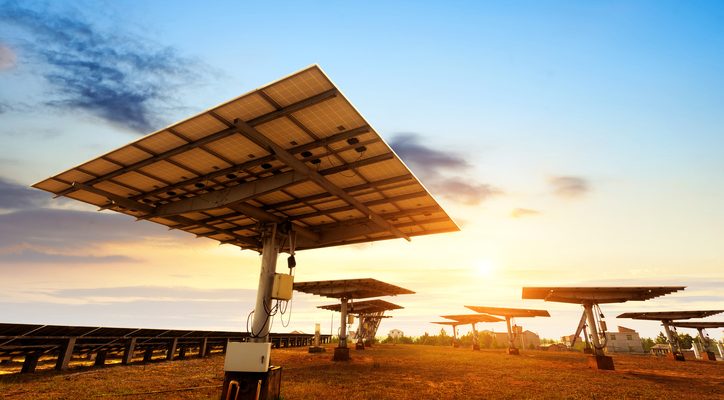Ground-mounted solar panels are a viable alternative for those desiring solar power, but who  are unable or unwilling to mount panels on the roof. Roof panels are convenient because the roof is often unshaded and used for little else. But what if your roof is small or shaded? What if you find roof mounted panel ugly? Ground-mounted panels can provide an easily-maintained, economically-sound, and aesthetically-pleasing solar power system.
are unable or unwilling to mount panels on the roof. Roof panels are convenient because the roof is often unshaded and used for little else. But what if your roof is small or shaded? What if you find roof mounted panel ugly? Ground-mounted panels can provide an easily-maintained, economically-sound, and aesthetically-pleasing solar power system.
Why Mount Panels on the Ground?
The quality and suitability of the roof, amount of available space, and your environmental needs all determine whether ground-mounted solar panels are an effective solution for your property.
Obstructed Sunlight
Does the roof receive ample sunlight throughout the day? Can light be increased by trimming back foliage? If you answered “no” to both questions, consider ground-mounted panels. Chimneys or other common architectural features can create long hours of shade, limiting the potential of roof-mounted solar panels to generate energy.
Little Roof, Little Power
The total surface area of installed solar panels impacts the amount of power a solar system generates. It’s a straightforward equation: a small roof limits the number of solar panels that can be installed. If available ground area is greater than available roof area, ground-mounted solar panels can provide more energy.
Angle of the Light
In addition to total sunlight, the angle at which light hits your roof impacts how much energy solar panels can produce. To maximize light, mount panels on a roof with a direct south, east, or west facing exposure. If your roof isn’t oriented in a direction that receives abundant light, consider ground-mounted panels.
Older Homes
An old roof can collapse under the weight of solar panels. Solar installation companies will gauge roof strength for safety. Survival Renewable Energy emphasizes, “Many solar companies will not install solar on a roof that is too old or in bad condition.” If the roof in in poor repair, ground-mounted panels may be the only viable option.
Roof Materials
A clay tile roof doesn’t preclude roof mounted panels, but does increase the difficulty and expense of installation. If you have a clay tile roof and the available ground space, ground-mounted solar panels are a good way to avoid the added cost and complication.
Ways They Work
Once you’ve opted to install ground-mounted panels, you next want to consider which panel design best suits your needs: stationary mounts or solar pole mounts. Both designs have the advantage of ground accessibility, and while the designs differ in size and appearance, your decision isn’t limited by roof style, size, or age.
Stationary Mounts
As the name suggests, stationary mounts aren’t easily moved. Stationary-mounted panels can be moved once or twice a year to find the most direct sunlight, but ideally, stationary mounts are installed where they will receive consistent year-round light. Though less flexible than pole mounts, stationary mounts tend to require fewer repairs, and so tend to cost less in the long run.
Solar Pole Mounts
As the sun arcs across the sky, pole-mounted panels automatically rotate to receive the most direct sunlight – and pole mounts can increase the production of your solar panels by 25 percent or more. Some pole mounts feature a single axis system, which allows side-to-side movement for tracking the sun through the day, while more sophisticated mounts feature a dual-axis system, which allows the panels to track seasonal changes as well.
While pole-mounted panels more efficiently receive sunlight than their stationary counterparts, remember: the more moving parts, the more chances for mechanical failure. Dual-axis pole mounts generate the most energy, but the mechanically complex dual-tracking system tends to fail more often than a single-axis system, and both have a greater fail rate than a stationary system.
Ground Quality
If ground-mounted solar panels sound like a good fit for your property, the next step is to assess the quality of the ground in which you intend to anchor the mounts.
Solar Power World describes a proper ground survey in great detail, and also explains how to decipher the result; “Knowing the results of a proper geotechnical investigation will allow contractors and installers to select the most appropriate mounting approach, as well as the type of racking necessary to work with the mounting system.”
Once you’ve selected a reputable solar-installation company, utilize their expertise to ensure your ground mounts suit your property. Environmental and solar-system factors such as soil composition, local climate conditions, module size, and array tilt determine what style of mounting foundation will last longest and function best.
A Solar Solution for Everyone
Thanks to overlooked solutions like ground-mounted panels, your solar provider can almost always identify a solar panel installation solution that surmounts the constraints of your property. Even if your roof is small, you have more shade than sunlight, or you just don’t like the look of black rectangles on your clay roof, give solar panels a second thought. Ground mounting the panels is just one of the many options available for adapting solar panel technology your home or business.
And of course, be sure to check out the federal incentives for installing solar panels. There are numerous incentives available for going solar, and none of them restrict where you install your panels.
Need good karma? Now you can get amore good karma than you can poke a sharp stick at… Just ‘like’ us on Facebook! Click here.




